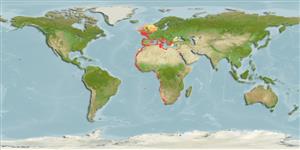ກຸ່ມປາກະດູກອ່ອນ (ເຊັ່ນ: ປາສະຫລາມ, ປາຜາໄລ) (sharks and rays) >
Torpediniformes (Electric rays) >
Torpedinidae (Electric rays)
Etymology: Torpedo: Latin, torpere = be sluggish (Ref. 45335).
More on author: Risso.
Environment: milieu / climate zone / depth range / distribution range
ນິເວດວິທະຍາ
ສັດທະເລ; ນ້ຳກ່ອຍ ກ່ຽວກັນຫີນ; ລະດັບຄວາມເລິກ 2 - 370 m (Ref. 4430). Subtropical; ? - 20°C (Ref. 10011); 60°N - 34°S, 19°W - 36°E (Ref. 114953)
Eastern Atlantic: northern UK (less common in southern North Sea and Kattegat) to Cape of Good Hope, South Africa. Also in the Mediterranean Sea.
Length at first maturity / ຂະໜາດ / ນ້ຳໜັກ / Age
Maturity: Lm 44.0, range 39 - 49 cm
Max length : 100.0 cm TL ຕົວຜູ້/ບໍ່ມີເພດ; (Ref. 27000); common length : 60.0 cm TL ຕົວຜູ້/ບໍ່ມີເພດ; (Ref. 114953); ນ້ຳໜັກສູງສຸດທີ່ເຄຍຈັດພີມມາ: 3.0 kg (Ref. 35388)
Short description
ສະລີລະວິທະຍາ | ການວັດແທກຮູບຮ່າງລັກສະນະພາຍນອກຂອງດິນ,ສັດ,ປາ…
ຄີ (ໜາມ)ແຂງຢູ່ຫຼັງປາ (ທັງໝົດ): 0; ຄີ(ໜາມ) ແຂງຢູ່ຄີກົ້ນປາ
ກຸ່ມປາກະດູກແຂງ
ຄວາມຖີ່ຂອງກຸ່ມຖ່າຍທອດພັນ
ປາທີ່ມີການເຄື່ອນຍ້າຍຈາກທະເລໄປຫານ້ຳຈືດ ແລະນ້ຳຈືດຫາທະເລ
ປາທີ່ມີການເຄື່ອນຍ້າຍຈາກທະເລແລະໄປໄຂ່ຢູ່ນ້ຳຈືດ
ຄີກົ້ນຂອງປາ
ສັດທີ່ມີກະດູກສັນຫັຼງ
ການຖ່າຍທອດທາງກຳມະພັນຈາກພໍ່ແມ່ຫາລູກ 0; ຄີກົ້ນຂອງປາ: 0; ສັດທີ່ມີກະດູກສັນຫຼັງ: 104 - 108. Disc-width around the same as its length, length and width 1,50 to 1,70 times in total length; dorsal fins more or less rounded, its base 1,50 times in its height (Ref. 39215).
Occurs in seagrass areas, rocky reefs, and adjacent soft bottoms (Ref. 12951). Avoids temperatures above 20°C (Ref. 10011). Nocturnal, usually burying itself during the day with only the eyes and spiracle jutting out (Ref. 12382). Feeds on small benthic fishes Trachurus, Mugil, Mullus, Dicentrarchus, Spondyliosoma, Boops, Labrus, Dascyllus, Pomacentrus) and crustaceans (Ref. 10011). Females outlive males; viviparous, neonates measuring 10-14 cm at birth (Ref. 10426). Produces 2-32 pups in a litter after a 10-month gestation (Ref. 12951, Ref. 114953). Males reaches maturity at ca. 30 cm TL, females at ca. 40 cm TL; born at 10-14 cm TL (Ref. 114953). Electrocytes start developing when the embryo weighs about 1 g; electric organs functional before birth and newborns can use their electric organ discharge (EOD) in capturing prey (Ref. 10428). Can produce electric discharges of up to 200 volts; EOD frequency up to 600 Hz. Jumps on fast-moving prey, paralyzing it with its EOD (Ref. 27000).
Exhibit ovoviparity (aplacental viviparity), with embryos feeding initially on yolk, then receiving additional nourishment from the mother by indirect absorption of uterine fluid enriched with mucus, fat or protein through specialised structures (Ref. 50449).
Stehmann, M. and D.L. Bürkel, 1984. Torpedinidae. p. 159-162. In P.J.P. Whitehead, M.-L. Bauchot, J.-C. Hureau, J. Nielsen and E. Tortonese (eds.) Fishes of the north-eastern Atlantic and Mediterranean. UNESCO, Paris. Vol. 1. (Ref. 2803)
IUCN Red List Status (Ref. 130435)
Human uses
ການປະມົງ: ທີ່ບໍ່ມີຄວາມສົນໃຈ; ຕູ້ປາ: ບ່ອນວາງສະແດງສັນນ້ຳຂອງລັດ
ຂໍ້ມູນຕື່ມອີກ
Age/Sizeການເຕີບໃຫຍ່Length-weightLength-lengthLength-frequenciesການວັດແທກຮູບຮ່າງລັກສະນະພາຍນອກຂອງດິນ,ສັດ,ປາ…ສະລີລະວິທະຍາຕົວອ່ອນການປ່ຽນແປງຂອງຕົວອ່ອນການທົດແທນທີ່ຄວາມອຸດົມສົມບູນBRUVS
ເອກະສານອ້າງອີງການລ້ຽງສັດນ້ຳຂໍ້ມູນການລ້ຽງສັດນ້ຳສາຍພັນກຳມະພັນElectrophoresesການຖ່າຍທອດທາງກຳມະພັນຈາກພໍ່ແມ່ຫາລູກພະຍາດການປຸງແຕ່ງNutrientsMass conversion
ຜູ້ຮ່ວມມືຮູບStamps, Coins Misc.ສຽງຫອຍມີພິດຊະນິດນຶ່ງທີ່ອາໄສໃນທະເລຄວາມໄວປະເພດການລອຍເນື້ອທີ່ເຫືອກOtolithsສະໝອງວິໄສທັດ
ເຄື່ອງມື
Special reports
Download XML
ແຫຼ່ງອີນເຕີເນັດ
Estimates based on models
Preferred temperature (Ref.
123201): 10.1 - 19.2, mean 14.1 °C (based on 392 cells).
Phylogenetic diversity index (Ref.
82804): PD
50 = 0.5005 [Uniqueness, from 0.5 = low to 2.0 = high].
Bayesian length-weight: a=0.01820 (0.01478 - 0.02241), b=2.93 (2.87 - 2.99), in cm total length, based on LWR estimates for this species (Ref.
93245).
ຊັ້ນເຂດຮ້ອນ (Ref.
69278): 4.5 ±0.0 se; based on diet studies.
ຄວາມຢືດຢຸ່ນ (Ref.
120179): ຕຳ່, ປະຊາກອນຕຳ່ສຸດທີ່ໃຊ້ເວລາສອງເທົ່າ 4.5 - 14 ປີ (Fec=5-32).
Fishing Vulnerability (Ref.
59153): High vulnerability (60 of 100).
Nutrients (Ref.
124155): Calcium = 5.92 [0.80, 27.36] mg/100g; Iron = 0.378 [0.092, 1.074] mg/100g; Protein = 19.4 [14.9, 22.8] %; Omega3 = 0.27 [0.11, 0.65] g/100g; Selenium = 14.8 [4.2, 42.9] μg/100g; VitaminA = 63.8 [17.2, 235.5] μg/100g; Zinc = 0.555 [0.260, 1.159] mg/100g (wet weight);
